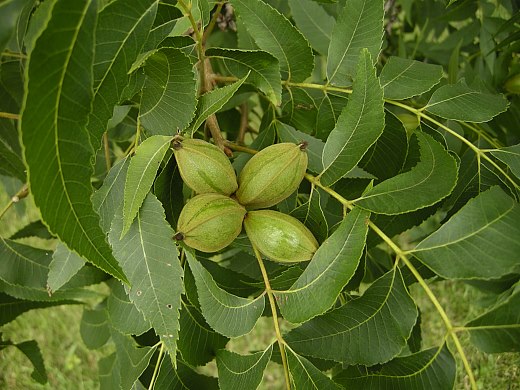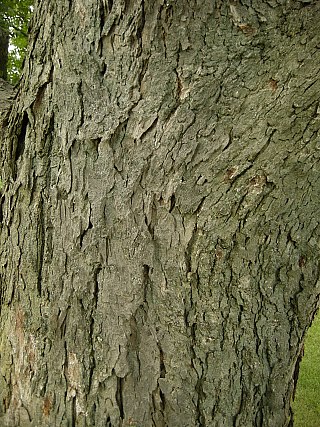Description: This tree is 70-150' tall at maturity, forming a trunk 2-6' across. In open areas, the trunk is relatively short, while the crown has a globoid form from widely spreading branches. In forested areas, the trunk is relatively longer and the crown is more narrow. Trunk bark of mature trees is gray to gray-brown and rough-textured; it has shallow irregular furrows and flattened ridges with barely discernible shapes. The bark of large branches is similar to trunk bark. Small branches are gray and smooth, while young twigs are brown and usually pubescent. Alternate compound leaves 1-2' long develop along the twigs; they are odd-pinnate, consisting of 9-17 leaflets. The leaflets are 2-7" long and ½-2½" across, lanceolate or lanceolate-oblong in shape, curved to one side, and coarsely serrated along their margins. The leaflets have asymmetric bases and elongated tips. Their upper surfaces are yellowish green to dark green and glabrous, while their lower surfaces are pale green and glabrous to sparsely pubescent. The petiolules (small stalklets at the bases of leaflets) are light green, usually pubescent, and short (about ¼" long). The central rachis (stalk) and petiole of each compound leaf are light green and usually pubescent.

Pecan is
monoecious with both staminate (male) and pistillate (female) florets
on the same tree. Short pistillate spikes develop at the tips of some
twigs; each spike has 2-10 greenish pistillate florets. Individual
pistillate florets are about 1/4" (6 mm.) long and 1/8" (3 mm.) across,
consisting of a
short tubular calyx, 4 bractlets of unequal size, and a pistil. The
bractlets have 4 erect to spreading lobes that are lanceolate in shape.
Drooping staminate catkins about 4-6" long develop from short spurs
along the twigs; these catkins are yellowish green and usually occur in
groups of 3. Individual staminate florets have a 3-lobed bractlet and
4-6 stamens; the central lobe of the bractlet is longer than the
lateral lobes. The blooming period occurs from mid- to late spring for
about 2 weeks. The florets are cross-pollinated by the wind. During the
summer, fertile pistillate florets are replaced by clusters of 1-6
fruits (nuts with thin husks). These fruits are about 2" long, 1"
across, and ovoid-oblongoid in shape. Along the length of each fruit,
there are 4 short wings. The husk surface is smooth and hairless; it is
initially light green, but later becomes brown or black. A mature fruit
partially divides into 4 segments (along its wings) to release the nut.
The nut surface is light brown and smooth; the interior of the nut has
sweet edible meat. This tree reproduces by reseeding itself.
Cultivation:
The preference is full or partial sun, moist conditions, and a fertile
loamy soil. The leaves develop relatively late in the spring, but
remain green into the fall before turning yellow. Allow plenty of room
for development: Pecan can become a big tree with a life expectancy
that may exceed 300 years.

Range & Habitat:
Pecan is a native tree that is occasional in southern and western
Illinois (see Distribution
Map). Habitats consist of rich mesic woodlands, moist
bottomland woodlands in river valleys, and tree plantations. Pecan is
typically found with other bottomland deciduous trees along major river
valleys. This tree is cultivated commercially for its valuable nuts;
less often it is cultivated as a landscape plant.
Faunal Associations:
The following moth caterpillars have been observed to feed on Pecan: Actias
luna (Luna Moth), Catocala maestosa (Sad
Underwing), Catocala piatrix (The Penitent), Catocala
vidua (Widow Underwing), Datana integerrima
(Walnut Caterpillar), and Lophocampa caryae
(Hickory Tussock Moth). Other insects that feed on Pecan include: the
aphids Longistigma caryae, Monellia
caryella, and Monelliopsis nigropunctata;
the plant bugs Lygocoris caryae, Orthotylus
ramus, and Plagiognathus albatus; the
leafhoppers Eratoneura osborni and Erythridula
cauta; the treehopper Carynota mera; and
the leaf beetle Metachroma marginale. In addition
to these species, many other insects are known to feed on Carya
spp. in general. Among vertebrate animals, Pecan nuts are an
important source of food. They are eaten by the Wood Duck, Wild Turkey,
Red-Bellied Woodpecker, Gray Squirrel, Fox Squirrel, Southern Flying
Squirrel, Eastern Chipmunk, White-Tailed Deer, Black Bear, and
White-Footed Mouse. White-Tailed Deer also browse on the twigs and
leaves. The tree sap of Pecan is a source of food to the Yellow-Bellied
Sapsucker. This tree provides good cover for various kinds of wildlife;
the Scissor-Tailed Flycatcher and other birds sometimes construct nests
in its branches.
Photographic Location:
The Arboretum at the University of Illinois in Urbana, Illinois.
Comments:
Pecan is renowned for its tasty nuts, which are used primarily in
desserts. This tree is in the same genus as the hickories (Carya
spp.) and it occasionally forms hybrids with some of these
species. Compared to other Carya spp., Pecan has
more leaflets (9-17) per compound leaf and its fruit is more elongated
in shape (about twice as long as it is across). It is possible to
confuse Pecan with Juglans nigra (Black Walnut) and
Juglans cinerea (Butternut) because they have a
similar number of leaflets, but the husks of their fruits do not divide
into 4 segments and they also lack wings. Unfortunately, multiple
spellings of the scientific name for Pecan are currently in use: Carya
illinoensis, Carya illinoiensis, and Carya
illinoinensis. Without examining the original manuscript that
introduced the current scientific name, it is difficult to determine
which spelling is correct. The spelling in Mohlenbrock (2002) has been
used here.